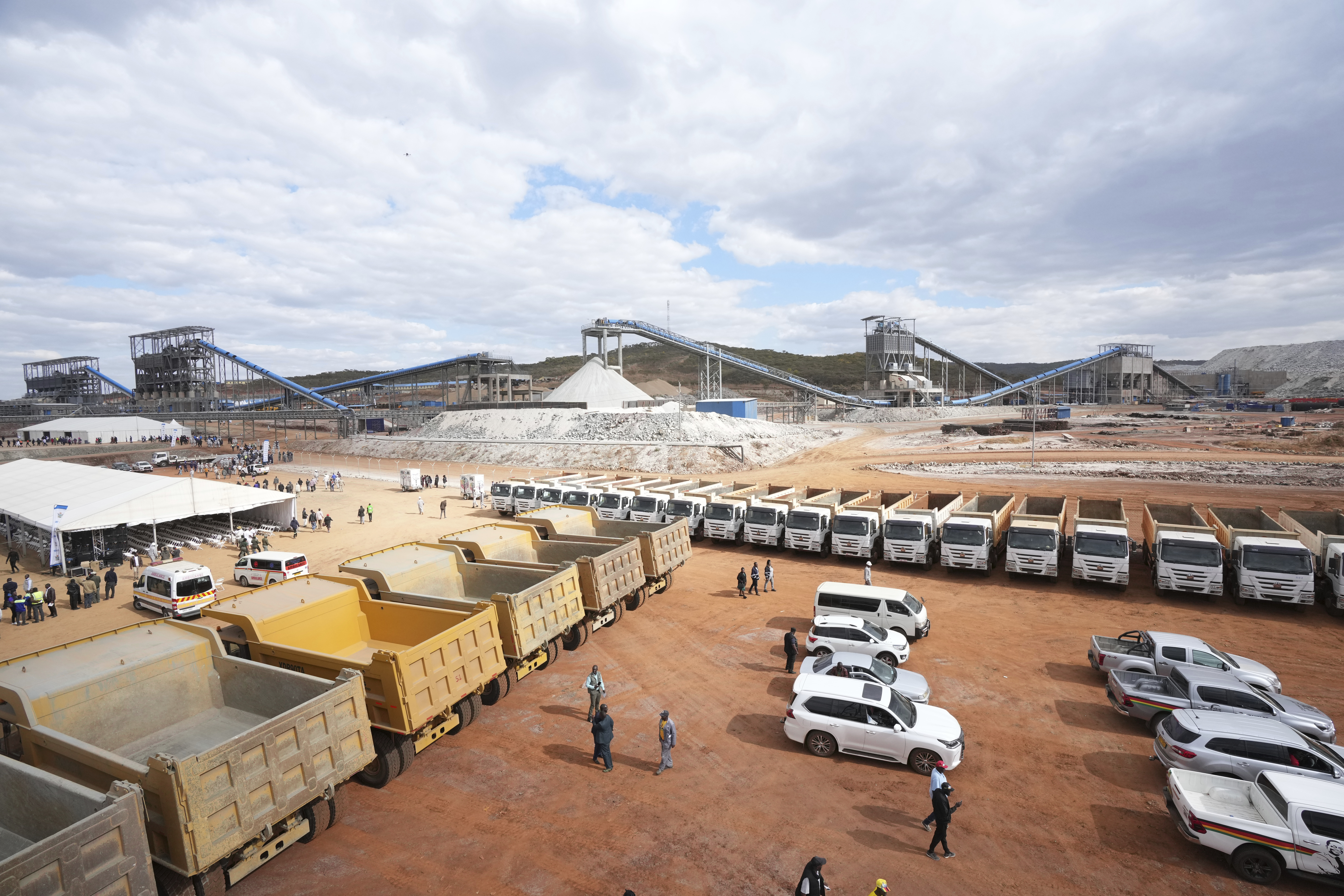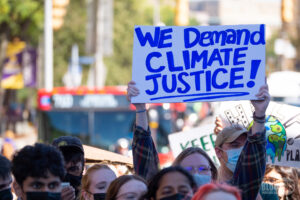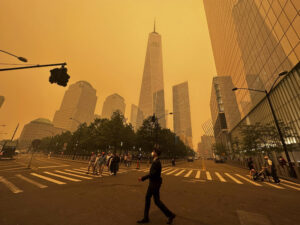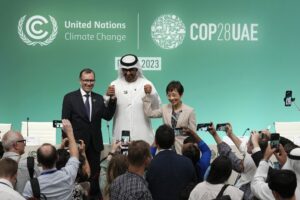Welcome to the New Green Colonialism
It’s time to flip the game upside down and end green colonialism by requiring a southernization of the north — forcing the latter to reduce its consumption of energy. Trucks and machinery are seen on the grounds of Prospect Lithium Zimbabwe's processing plant in Goromonzi about 80 kilometers southeast of the capital Harare, Wednesday, July 5 2023. A Chinese mining company on Wednesday commissioned a $300 million lithium processing plant in Zimbabwe. Zimbabwe has one of the world’s largest reserves of the metal, which has seen a surge in demand globally due to its use in batteries in electric cars. (AP Photo/Tsvangirayi Mukwazhi)
Trucks and machinery are seen on the grounds of Prospect Lithium Zimbabwe's processing plant in Goromonzi about 80 kilometers southeast of the capital Harare, Wednesday, July 5 2023. A Chinese mining company on Wednesday commissioned a $300 million lithium processing plant in Zimbabwe. Zimbabwe has one of the world’s largest reserves of the metal, which has seen a surge in demand globally due to its use in batteries in electric cars. (AP Photo/Tsvangirayi Mukwazhi)
In a fit of madness or just plain desperation, you’ve enrolled in a get-rich-quick scheme. All you have to do is sell some products, sign up some friends, make some phone calls. Follow that simple formula and you’ll soon be pulling in tens of thousands of dollars a month — or so you’ve been promised anyway. And if you sell enough products, you’ll be invited into the Golden Circle, which offers yet more perks like free concert tickets and trips to Las Vegas.
Still, I’m sure you won’t be surprised to learn that there’s a catch. If you don’t sell a pile of products or sign up a ton of friends to do the same, the odds are that you’ll end up losing money, no matter how hard you work, especially if you take out loans to build your “business.”
The founders of multi-level marketing schemes always make a lot of money. Some of their friends become wealthy, too. But 99% of those who sell the products, whether cosmetics or dietary supplements, lose money. That’s worse than a conventional pyramid scam, which fleeces only nine out of every 10 people involved.
Now, imagine that you’re a poor country. The international financial institutions (IFIs) promise that, if you follow a simple formula, you, too, will become a wealthy nation. In a fit of desperation or madness, you take out loans from those same IFIs and commercial banks, invest in building up your export industries, and cut back on government regulations. Then you wait for the good news.
Since 1995, in fact, the top 1% of the wealthiest among us have accumulated 20 times that of the bottom 50%.
But of course, there’s a catch. You have to sell a staggering number of exports to actually make money. Meanwhile, you have to repay those loans, while covering the compounding interest payments that accompany them. Soon you’re caught in a debt trap and falling ever further behind the wealthy countries of the north. The main winners? The corporations that flooded into your country in search of tax incentives, cheap labor, and lax manufacturing and mining regulations.
The nation-states that founded the modern global economy have indeed made tons of money, as have some of their friends and allies. Despite the devastation of World War II, for instance, Japan was able to scramble up the ladder again to join the treehouse club of powerful nations. Meanwhile, in a single generation, South Korea’s economy was transformed from the per capita gross domestic product of a Ghana or Haiti in 1960 into one of the world’s most powerful by the 1980s. In Latin America, Chile, Colombia, and Costa Rica all managed to join South Korea in the Organization of Economic Cooperation and Development, a collection of the planet’s 38 most prosperous countries.
But in 2023, there’s a catch to climbing that ladder into the industrialized world. As the board of directors of the club of the wealthy points out, the classic ladder of development, industrialization itself, has become rickety and ever more dangerous. After all, it requires energy traditionally supplied by fossil fuels, now known to radically heat up the planet and endanger the very survival of humanity. Today, countries aspiring to join the charmed circle of the wealthy can no longer hope to climb that ladder in any usual fashion, thanks in part to the carbon-neutrality pledges virtually all nations made as part of the Paris climate accord.
The Global South is divided on how to respond. For instance, as the world’s second-largest consumer of coal and third-largest consumer of oil, India wants to grow in the old-fashioned fossil-fuelized way, becoming the last one up that ladder, even as its rungs are disintegrating. Other countries, like renewables-reliant Uruguay and carbon-neutral Suriname, are exploring more sustainable paths to progress.
Either way, with global temperatures setting ever more extreme records and inequality worsening, poor countries face their last shot at following South Korea and Qatar into the ranks of the “developed” world. They may fail, along with the rest of us on this overheating planet, or perhaps one or two might get lucky and make it into the club. However, with some clever negotiating, judicious leveraging of resources, and a lot of solidarity, it’s just possible that they could team up to rewrite the very rules of the global economy and achieve a measure of prosperity for all.
Growing Inequality
The boosters of globalization point to a steady decline of inequality among nations between 1980 and 2020, largely because of the explosive economic growth of China and other Asian countries like Vietnam. However, those boosters often fail to mention two important facts: in 2020, such inequality was still roughly the same as it had been in 1900 when colonialism was in full swing. Meanwhile, in recent decades, inequality within countries has skyrocketed. Since 1995, in fact, the top 1% of the wealthiest among us have accumulated 20 times that of the bottom 50%.
The Covid pandemic only made matters worse. According to one estimate, it threw 90 million people into extreme poverty, while increasing the wealth of billionaires more rapidly in just two pandemic years than in the previous 23 years combined.
And mind you, the super-rich no longer reside only in the prosperous “north.” China and India now have the most billionaires after the United States. The consolidation of obscene wealth alongside abject poverty is one reason inequality has risen more rapidly within countries than between them.
But something else strange is happening. In addition to making the ladder of fossil-fuelized industrialization more difficult to climb, climate change has been pushing the architects of the global economy to rethink their animus toward state intervention. Accelerating as it is due to a fundamentalist faith in markets, climate change may also be delivering the coup de grace to neoliberalism.
Climate Debts
During the Industrial Revolution and the ensuing century and a half of global economic expansion, the countries of the North grew wealthy by exploiting oil, natural gas, and coal. In doing so, they pumped trillions of tons of carbon dioxide into the atmosphere. Poorer countries generally supplied the raw materials for that “miracle of progress” — at first, involuntarily thanks to colonialism and then more-or-less voluntarily through trade.
From 1751 to 2021, the United States was responsible for fully one-quarter of all carbon emissions, with the members of the European Union in second place at 22% (followed by China, India, Japan, Russia, and other major powers). On the other hand, Africa, Latin America, Southeast Asia, and Oceania have collectively contributed only a tiny fraction of those emissions over time. Of the existing carbon budget — the amount the world can emit without crossing the 1.5C degree red line set by the Paris climate accord — only 250 gigatons remain. That’s approximately what China alone had emitted by 2021 while muscling its way into the clubhouse of the rich and powerful.
The wealthy club members have all now embarked on transitions to “clean energy.” The European Union’s “Fit for 55” aims to reduce its carbon emissions by 55% by 2030. The Biden administration pushed through the deceptively named Inflation Reduction Act to incentivize states, corporations, and individuals to move away from fossil fuels, so that the United States could become carbon-neutral by 2050. In both cases, the state is playing a much more active role in guiding the transition than would have been tolerated in the heyday of Thatcherism or Reaganism (or, today, Trumpism).
The Global South, which bears little responsibility for the climate mess the planet faces, doesn’t have the necessary billions of dollars to devote to “clean energy transitions.”
The Global South, which bears little responsibility for the climate mess the planet faces, doesn’t have the necessary billions of dollars to devote to “clean energy transitions.” So, because climate change knows no borders, in 2010, the richer countries promised to contribute $100 billion a year to fund “mitigation” (emissions reductions) in the Global South. However, that promise has proved to be — the perfect image for our overheated moment – mostly hot air. Ten years later, according to Oxfam, the wealthy nations have managed to mobilize at most $25 billion in real assistance annually.
Meanwhile, climate change is wreaking havoc in the here and now. Though Canadian wildfires and European heat waves have dominated the climate headlines in the north this summer, the effects of climate change are actually being disproportionately felt south of the equator. According to one estimate, by 2030, developing countries will be hit with climate bills of between $290 billion and $580 billion annually.
Last year, rich countries made another pledge of money, this time to a “loss and damage fund” to compensate poor nations for the ongoing impacts of climate change. Those funds, however, have yet to come into existence, while the desperately poor countries of the Global South await the next round of climate negotiations — in oil-rich Dubai of all places — to find out how much is involved, from whom, and for whom.
Promises, promises.
So far, the poorer countries have been shaking their tin cups outside the meetings of the powerful, hoping that some loose change will eventually trickle down to them. But there may be another way.
Global Just Transition
The fossil-fuel-free future the Global North is touting depends on critical materials like lithium, cobalt, and rare earth elements to build electric batteries, solar panels, and windmills. Most of these essential assets are located in the south. In one of those ironies of history, the economic development of the north once again depends significantly on what lies beneath the ground (and the oceans) south of the equator. In this brave new world of “green colonialism,” the north is maneuvering to grab such needed resources at the lowest price possible in part by perpetuating for the poor the very neoliberal model of “less government” that it’s begun to abandon itself.
There’s also a Cold War twist to this tale. According to policymakers in Brussels and Washington, the “clean energy” transition shouldn’t be held hostage by China, which mines and processes many of its critical minerals (producing 60% and processing 85% of all rare earth elements). China might one day decide to shut down the supply chain of such critical minerals, a foreshadowing of which took place this summer when Beijing imposed export controls on gallium and germanium in response to a Dutch ban on certain high-tech exports to China. The Chinese leadership will undoubtedly continue out-negotiating the West to gain privileged access to what it needs for its own high-tech industries.
A new “mineral rush” is underway. The European Union (EU) is now debating a “Critical Raw Materials Act” meant to reduce dependency on Chinese inputs through more mining closer to home, from Sweden to Serbia, not to speak of more “urban mining” (that is, recycling materials from used batteries and old solar panels).
Europe is also locking in deals with mineral-rich countries in the Global South. The EU typically negotiated a trade agreement with Chile that ensures EU access to that country’s lithium supplies, while making it more difficult for Chile’s government to supply its own manufacturers with cheaper inputs.
Washington, meanwhile, put a provision in the Inflation Reduction Act to ensure that electric car manufacturers source at least 40% of their batteries’ mineral content from the United States or U.S. allies (read: not China). That percentage is to rise to 80% by 2027. Washington is not only scrambling to secure its own critical minerals, but forcing allies to cut ties with China and compete for sources elsewhere in the world.
They would be hard-pressed to do so without creating “zones of sacrifice,” destroying communities and ecosystems around mineral extraction sites.
Such an effort to “secure supply chains,” while a blow to China, represents a possible boon for the Global South. A country like Chile, which commands so much of the lithium market, can theoretically negotiate more than just a good price for its product. It could leverage its mineral riches to acquire valuable technology, intellectual property, or greater control over the overall supply chain. Collectively, those mineral suppliers could also take a page from the playbook of the oil producers. Indonesia, for instance, has already floated the idea of a nickel cartel.
Such strategies, however, face a threefold challenge. The United States and Europe are already boosting mining at home to become more self-sufficient. Then there’s the prospect that such minerals will be rendered obsolete by technological advances, much as the United States created a synthetic substitute for rubber when supplies became tight during World War II. Scientists are now racing to invent electric batteries that don’t depend on lithium or cobalt.
Even more worrisome are the environmental consequences of such mining. The countries of the Global South could indeed use “ladders” made of lithium, cobalt, or nickel to climb into the club of the wealthy. But they would be hard-pressed to do so without creating “zones of sacrifice,” destroying communities and ecosystems around mineral extraction sites.
So, let’s take a fresh look at the cartel idea. Venezuela originally proposed the Organization of the Petroleum Exporting Countries (or OPEC) as a method of reducing oil consumption. The problem Venezuela grasped 70 years ago was not just the low price of what the then-Venezuelan oil minister called “the devil’s excrement” but the unsustainable nature of a global dependency on fossil fuels. OPEC was to help conserve resources. Could a mineral cartel serve that very purpose?
Breaking the Cycle
The central problem facing the planet is not just carbon emissions and climate change. They’re both, in their own fashion, symptoms of an even larger crisis of the overconsumption of resources, including energy. Consider one minor example: the amount of stuff Americans buy at Christmas and then return without using amounts to $300 billion a year. That’s more than the economic output of Finland, Peru, or Kenya.
That gives “shop ’til you drop” a new meaning.
Instead of dreaming of consuming at the same rate as the Global North — inconceivable given the planet’s shrinking resource base — the Global South could use its mineral leverage to effectively lessen inequality on a planet-wide basis.
Rather than building a different ladder to climb into prosperity, the countries of the Global South could take the unprecedented challenge of human-induced climate change as an opportunity to rewrite the rules of the global economy. Instead of dreaming of consuming at the same rate as the Global North — inconceivable given the planet’s shrinking resource base — the Global South could use its mineral leverage to effectively lessen inequality on a planet-wide basis. In practice, that would mean forcing the North’s middle class to begin trimming its consumption by reducing the supply of fossil-fuel energy to the addicted.
In a referendum in Ecuador last month, its citizens voted to keep the oil in the Yasuni National Park beneath the ground. A number of countries in Oceania — Fiji, the Solomon Islands, Tonga — have similarly endorsed a “non-proliferation treaty” for fossil fuels that would phase out oil, gas, and coal production. Great Britain and the EU have considered rationing plans for fossil fuel.
Nor can the rich be allowed to sit on their billions while the planet burns. The wealth taxes that some countries have implemented — and others like the United States are now considering — would go a long way toward shifting funds from the super-rich to the greatest victims of climate change and biodiversity loss. Consider this slogan for our changing times: more butterflies, fewer billionaires.
The global economy is essentially on a downward debt spiral for the poor and an upward consumption spiral for the rich. In short, it’s a rigged game. The solution is not to usher a few lucky countries into the world of unsustainable excess, which would just be a new version of green colonialism.
Rather, it’s time to flip the game upside down and end that very green colonialism by requiring a southernization of the north — forcing the latter to reduce its consumption of energy and other resources to meet that of the Global South. The inequality of industrialization got us into this crisis. Addressing that inequality is the only way out.
Your support matters…Independent journalism is under threat and overshadowed by heavily funded mainstream media.
You can help level the playing field. Become a member.
Your tax-deductible contribution keeps us digging beneath the headlines to give you thought-provoking, investigative reporting and analysis that unearths what's really happening- without compromise.
Give today to support our courageous, independent journalists.








You need to be a supporter to comment.
There are currently no responses to this article.
Be the first to respond.